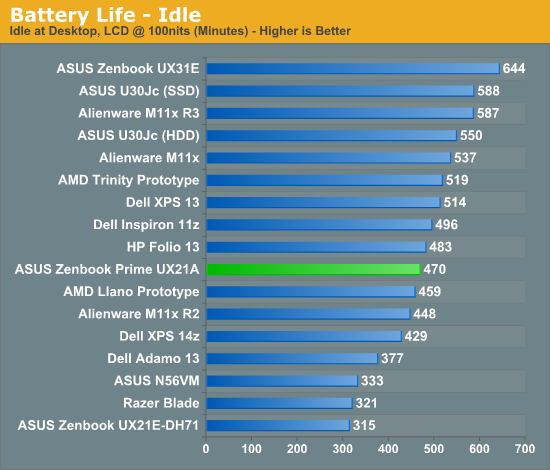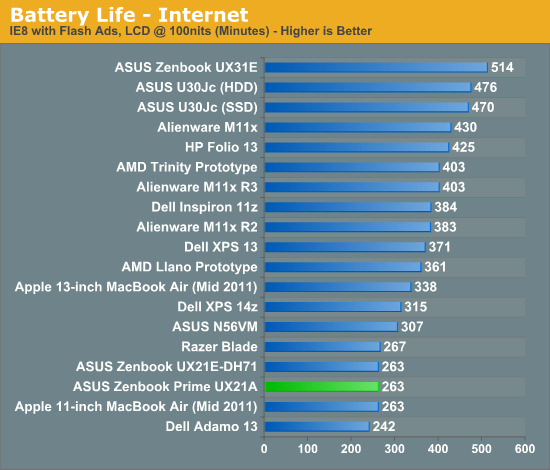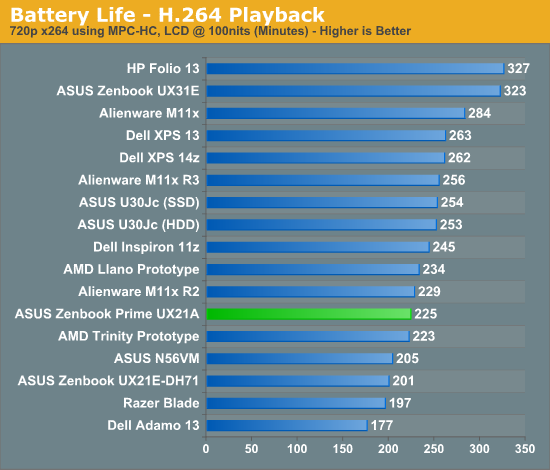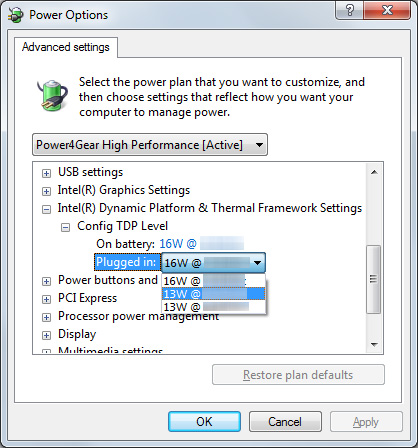ASUS Zenbook Prime (UX21A) Review: The First of the 2nd Gen Ultrabooks
by Anand Lal Shimpi on May 22, 2012 2:46 PM EST- Posted in
- Laptops
- CPUs
- Asus
- Ivy Bridge
- Zenbook
- Zenbook Prime
- Ultrabook
- Notebooks
Battery Life
Generally speaking, the 11-inch Zenbook Prime delivers about the same amount of battery life as its predecessor. For some reason we're able to hit much longer idle battery life on the Prime than the original Zenbook although I'm still trying to find out why. There's also an 11% improvement in our x264 playback test, but on average I'd expect to see similar battery life to the Sandy Bridge model - just with better performance. Note that these results also come despite the fact that ASUS is driving a much higher resolution, and presumably higher power, display than the original Zenbook.



The Zenbook Prime bucks the trend Jarred saw with the first Ivy Bridge notebook review where battery life took a small step backwards. These results bode well for future Ivy Bridge notebooks and Ultrabooks. It still remains to be seen if Intel's 22nm process will actually give us a battery life advantage in any notebook compared to its predecessor. It's possible that we are seeing some of the benefits of 22nm here already and they are simply offset by the more power hungry display. With the move to 22nm Intel should have a better hold on active power and leakage, but it's always possible that we'll have to wait until Haswell for the process to really be exploited.
Just like last time, ASUS has a couple of widgets to quickly change between power settings. The instant on widget lets you switch between suspend to RAM and suspend to disk modes. The former is expected to deliver up to 2 weeks of standby battery life, while the latter can push up to 150 days. I didn't have the time to test these claims (life is short, I draw the line at spending it testing claims of 150 day standby battery life). ASUS once again includes a counter that estimates how long your system will last in either mode based on current charge levels and power usage.
The next widget is a quick tool to let you switch between high performance and battery saver Power4Gear power profiles. You can customize these profiles via the Windows control panel, but it's nice to have a button on the desktop that lets you quickly switch between them.
Configurable TDP
One feature of Ivy Bridge that we haven't been able to test until now is configurable TDP. While most Ultrabook CPUs ship with a 17W TDP, that's mostly an arbitrary thermal/power rating. If an OEM wants to design a chassis that can only accept a 13W part it previously had to hope that Intel would make such a thing. Alternatively, the OEM could underclock/undervolt a 17W chip on their own and hope to mimic Intel's validation and deliver a 13W configuration of their own. The former requires that a significant number of OEMs demand the part, while the latter is just too risky for the larger OEMs (get too aggressive on the undervolting side and end up with a bunch of unstable systems). The solution Intel proposed with Ivy Bridge is configurable TDP. For Ultrabooks this means you can set a 17W part to 13W.

Currently the setting is hidden away in Windows 7's power management settings. Once again I've had to censor the clock speeds here due to Intel's Ultrabook embargo:
You can map the 13W settings to the battery saver profile and then, at the click of a button, have a 13W Zenbook Prime instead of a 17W model. The difference in performance isn't significant however:
| ASUS Zenbook Prime Configurable TDP Performance - Cinebench 11.5 (Multithreaded) | |||||||
| 16W - Max Freq | 13W - Mid Freq | 13W - Lowest Freq | |||||
| ASUS Zenbook Prime UX21A | 2.79 | 2.67 | 2.67 | ||||
I'm still running battery life tests to quantify the impact on power consumption, but it's conceptually a neat thing to see in action finally. I suspect configurable TDP is going to play a major role with Haswell and convertible/dockable Ultrabook-tablet hybrids.
Thermals and Noise
As with most high performance notebooks that are this thin, cooling is difficult. Under load the fans in the Zenbook Prime are definitely audible, but in general ASUS does a better job cooling everything inside the Zenbook Prime than Apple does in the MacBook Air. I suspect much of this boils down to how aggressive Apple is about keeping fan speed/noise down compared to ASUS' desire to maintain a certain temperature level inside the chassis.










192 Comments
View All Comments
techexperience - Wednesday, May 23, 2012 - link
So, if what I see is correct, (and anand always delivers).The only difference between the Zenbook Prime UX32 $799 and $999 is hardisk space? From 320 GB to 500 GB for $200?By the way great post, Anand, as usual.
http://techexperience.net
ReverendDC - Wednesday, May 23, 2012 - link
I believe that the UX32 is also a little thicker, and the non-DV versions have a dedicated GPU. The hard drives are also platter, not SSD.ReverendDC - Wednesday, May 23, 2012 - link
Sorry, the DV version comes with the dedicated GPU.Reflex - Wednesday, May 23, 2012 - link
Likely a faster CPU as well.UrQuan3 - Wednesday, May 23, 2012 - link
Darn, I went with a Samsung 9 last year and can't afford to replace it yet. 13.3 is too big for me and 1366x768 is too low res. 12" and 1080p would be nice. Looks like an acceptable color gamut as well.Let's not make excuses for poorly written GUIs. They should resize. Games don't have a problem with that.
I do home Microsoft catches their resolution-vs-size mistake on Metro. Last I checked, Metro used fixed sizes and used higher resolutions to put more on the screen instead of allowing app links to resize. They were assuming that high resolution screens are also physically bigger. Of course that would be awful on a small, high res screen. Anyone know if they changed that?
Stanly.ok - Wednesday, May 23, 2012 - link
I look at official Asus slides (particularly at the top of second page) and can't help but wonder ... what kind of marketer or manager made them at the last moment instead of giving this job to a professional?!name99 - Wednesday, May 23, 2012 - link
" In practice I saw a doubling of performance under the same conditions as the original Zenbook (80Mbps vs. ~40Mbps)."This seems really bad. You should have got a doubling from 40MHz 5GHz channels, and a doubling from 2x MIMO. Are you sure the laptop and the base station are both set up optimally (most importantly both are in Greenfield mode so they're not wasting a huge amount of time with g compatibility)?
My 3 yr old MBA gets around 13MB/s to an 18 month old AEBS, and I've seen the new MBAs get around 20MB/s to that AEBS, and I expect even better to the newest AEBS.
IntelUser2000 - Friday, May 25, 2012 - link
I think its the way Anand tests it. On and Macbook Air 2011 review he gets 117Mbps which is 14.6MB/s.dczyz - Wednesday, May 23, 2012 - link
Since we dont have a new MX in the small form factor yet, that UX32VD-DB71 maybe what I do with. Cant wait to see a review on it.agent2099 - Wednesday, May 23, 2012 - link
The main fault I see in this device is the VGA port. They should have included a mini display port to complement the HDMI port. That way you could run two high-resolution displays from the laptop. With my current laptop I have the HDMI out going to the television and I have the mini display port going to my 24 inch monitor.